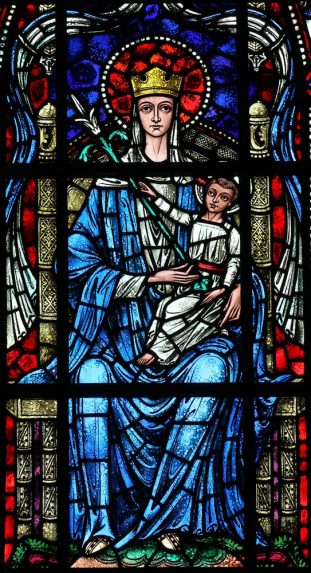Norwich Roman Catholic Cathedral, Norfolk
Address
The cathedral of St John the Baptist, Unthank Road, Norwich NR2 2PATheme
Overview
Work commenced on the church in 1882, with Henry Howard, 15th Duke of Norfolk as patron, and was completed in 1910. It was raised to cathedral status in 1976.
Most of the stained glass was made and designed over this 30-year period by one organisation, John Hardman & Co. of Birmingham, under the direction of John Hardman Powell and his son, Dunstan Powell.
Although some of the windows were destroyed during WWII, most notably the north windows and those in the Walsingham Chapel, their replacements were remade in the same style and in the case of the north windows with little alteration. Additional post-war refurbishment (by G. King and Son of Norwich) which included some interchange between aisle and clerestory windows to lighten the interior, was also undertaken sympathetically to the original plans.
The uniformity in the design of the glass makes a huge impact on the building, which is probably best summed up by the architectural historian Nikolaus Pevsner: ‘The thing which gives the interior its peculiar holiness is the stained glass…Its colours are dark and glowing, its composition designed on the principle of 13th century windows… (They are) supremely well done.’
Further information: Norwich Heritage – Norwich Roman Catholic Cathedral
Highlight
The central window in the Walsingham ChapelArtist, maker and date
Originally designed by Clayton & Bell, c.1909, remade & updated by G King & Son after World War TwoReason for highlighting
All windows in the chapel were originally made and designed by the renowned firm of Clayton & Bell to tell the history of the shrine at Walsingham from the date of its foundation in 1061 to its destruction at the reformation. Scenes include visits by ancestors of the Duke of Norfolk, who of course financed the building of the Cathedral. During WWII the windows were severely damaged. They were subsequently remade and the subject matter updated.
Particularly striking is the central window, in which Our Lady of Walsingham sits majestically on her throne holding the infant Jesus, while below we see her coat of arms. At the base of the window Queen Katherine kneels at the shrine giving thanks for the victory at Flodden Field (9th September 1513). On her right kneels the victor Thomas Howard, Earl of Surrey, soon to be the Duke of Norfolk in front of his standing wife, Agnes. The famous wooden image associated with Walsingham, stands to the right of the altar.
Artist/maker notes
Clayton & Bell is one of the best known and most prolific studios of the Victorian Age. The original partners, John Richard Clayton (1827-1913) and Alfred Bell (1832-95), were encouraged into business by Sir George Gilbert Scott, who would go on to use the firm for numerous commissions, as did G E Street and J L Pearson.
While the output of the firm would become prodigious, it also affected the development of stained glass through the significant number of artists, who spent time with the firm, including Charles Eamer Kempe, John Burlison and Thomas Grylls, and Robert Bayne.
Angels & Icons: Pre-Raphaelite Stained Glass 1850-1870 by William Waters (Seraphim Press Ltd 2012)
G King& Son Ltd, Lead Glaziers of Norwich, was a family affair, handed down from father to son through three generations. Founded in 1927, it became a by-word for quality in stained glass restoration, conservation and the understanding of the medium. The workshop finally closed in 2003, with the retirement of Michael King.



Comments by
Norfolk Stained Glass